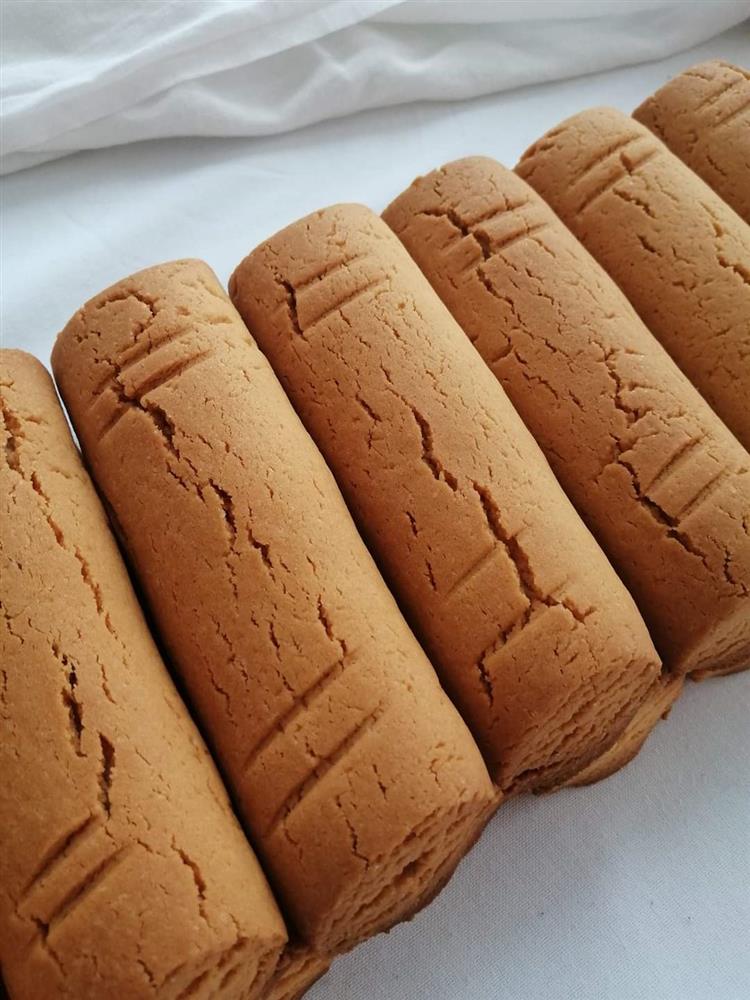Rize enişte lokumu is a unique bakery product specific to Rize province, located in Türkiye's Black Sea Region. It has been produced for many years as part of traditional wedding culture. It was registered with a designation of origin on May 26, 2021, and its application was made to the Turkish Patent and Trademark Office on July 20, 2020, with application number "C2020/202". The owner of the geographical indication is Rize Municipality, and production can only be carried out within the geographical boundaries of Rize province.

Rize Enişte Lokumu (T.C. Ministry of Culture and Tourism)
Features
Rize enişte lokumu is a roll-shaped cookie, 15 cm long, 2 cm thick, and weighing 130 (±5) grams. Structurally, its base is flat, while its top is slightly puffed due to the natural baking process. The upper part has golden-brown tones, and the bottom part is darker as it is more browned. Before the product is placed in the oven, horizontal cuts are made at the ends and the middle of the top, approximately 1 cm apart, to give it a visual character. These cuts are in the form of sharp lines.
Cultural and Sociological Context
Rize enişte lokumu also holds an important place in the region's specific marriage traditions. The product's history dates back to the 1800s, and it is particularly used in wedding ceremonies and the tradition of sending dowry bundles (bohça) that follow these ceremonies. This cookie, offered to guests at weddings and included in the groom's dowry, is sent back to the groom's home during the bride's visits to her paternal home. Initially, this product was only produced at home, but today it is also produced for commercial purposes.
Ingredients and Production Method
The ingredients required for the production of Rize Enişte Lokumu are as follows:
- 1000 (±100) g butter (must be produced in Rize)
- 3750 (±375) g wheat flour
- 1500 (±150) g granulated sugar
- 0.25 (±0.04) liters of water
- 60 (±5) g baking powder
- 6 (±1) eggs
- Half a lemon
Butter, granulated sugar, water, and half a lemon are boiled over low heat. After the mixture boils, it is cooled to room temperature. Then, baking powder and eggs are added, and flour is gradually incorporated as the dough is kneaded. The resulting dough is kneaded by hand or machine for approximately 3-5 minutes until it reaches an earlobe-like consistency. Strips 15 cm long and 2 cm thick are cut from the prepared dough. Two cuts are made on each end and in the middle of the strips, 1 cm apart. It is baked in an oven at 170-180 °C for approximately 35 minutes. The weight of the baked product is 130 (±5) g.
Packaging and Consumption
After baking, Rize enişte lokumu are individually wrapped with stretch film and stacked for sale. The product is produced and consumed daily.
Geographical Boundary and Production Conditions
All production processes of Rize Enişte Lokumu can only be carried out within the borders of Rize province. It is mandatory for the production stages to occur within the geographical boundary. This stems from both the historical origin of the product and the requirement that butter, one of the main ingredients used, must be produced in Rize.
Registration and Inspection Process
Rize Enişte Lokumu has been registered as a designation of origin by the Turkish Patent and Trademark Office. The phrase "Rize Enişte Lokumu" along with the relevant logo and designation of origin emblem must be present on the product or its packaging. If this use is not possible, the phrase and emblem in question must be displayed visibly at the establishment.
Inspection activities are carried out under the coordination of Rize Municipality by a four-person inspection authority comprising one representative each from Rize Municipality, Rize Chamber of Commerce and Industry, Rize Chamber of Tradesmen and Artisans, and Rize Bakers' Chamber. Inspections are conducted regularly three times a year; additionally, inspections can always be carried out upon complaint or when deemed necessary.
The inspection criteria are as follows:
- The butter must be produced in Rize,
- Suitability of ingredients and their proportions,
- Adherence to the production method,
- Suitability of the product in terms of shape, smell, and taste,
- Correct use of the designation of origin, logo, and phrase.
The inspection authority may obtain expert support or purchase services from public or private organizations when necessary.


